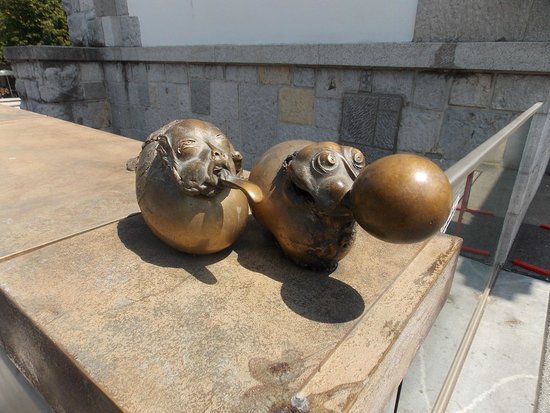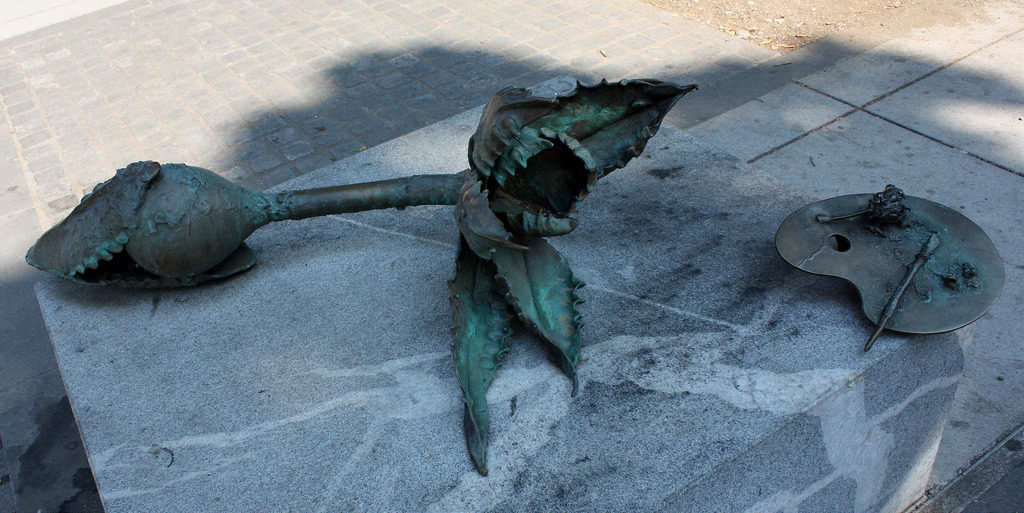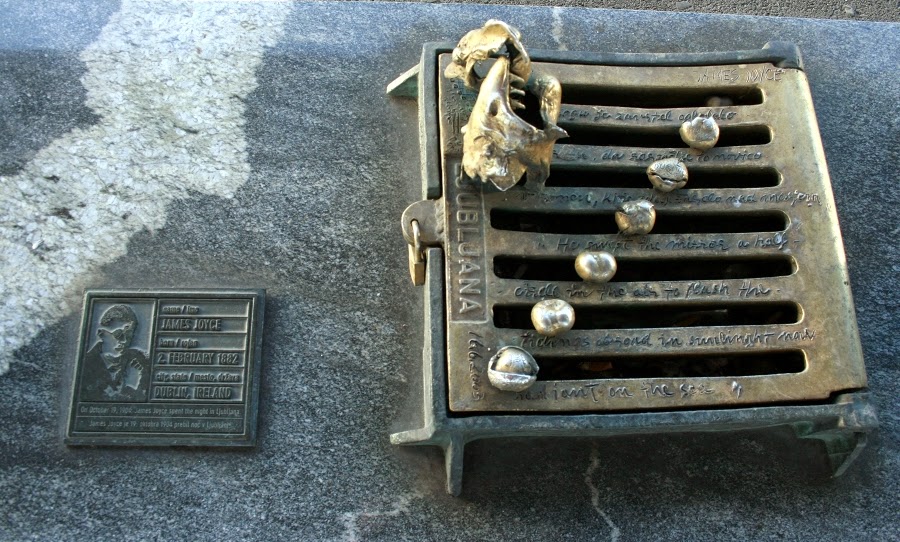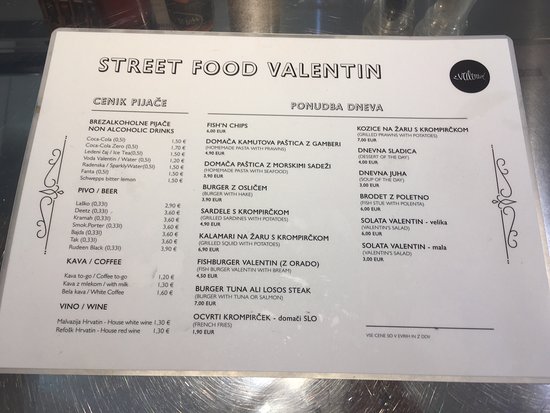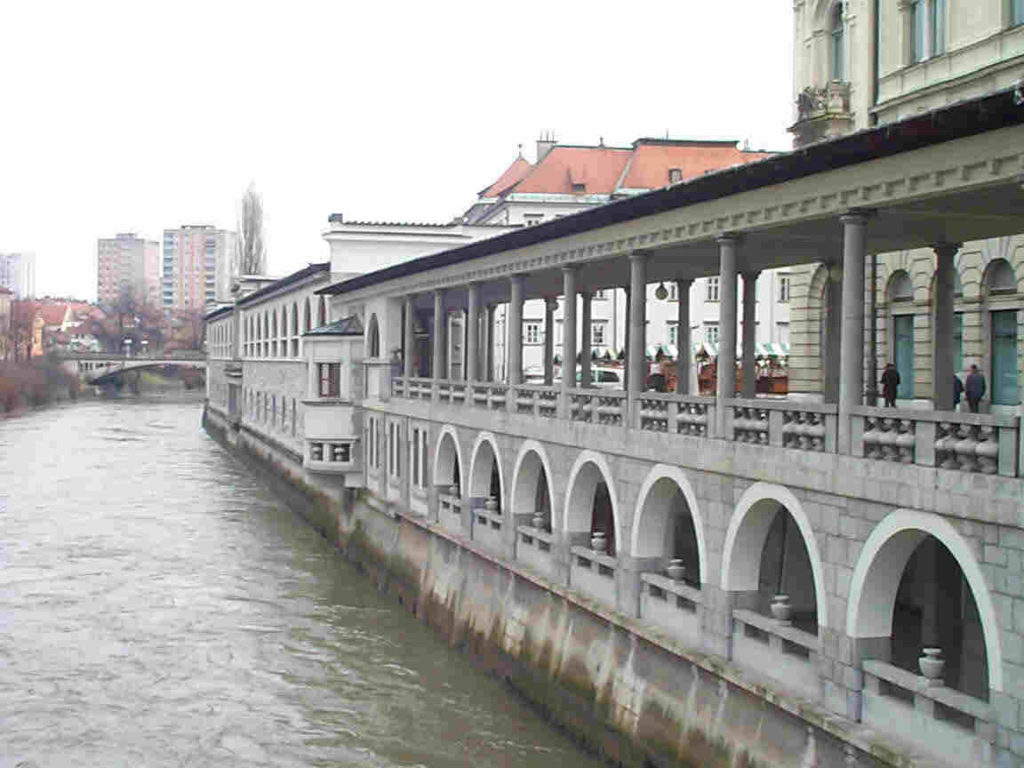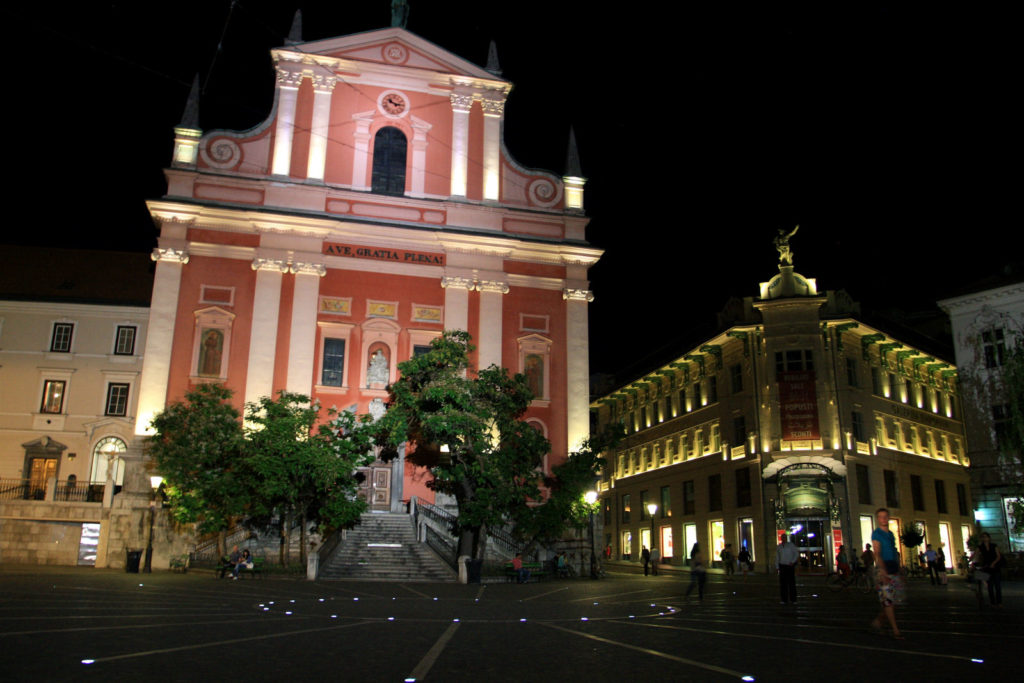It’s time to take a look at the sculptures by Jakov Brdar that cross and adorn either side of the Butcher’s Bridge. In a comment on a previous post about Ljubljana, Connie wrote that it “Felt Parisian, for some reason, only with more whimsy.” Perhaps that’s because I hadn’t yet exposed her to some of these Brdar works that I perceived as more dark than whimsical. On one side, there’s Adam and Eve banished from paradise
On the bridge itself, there’s a satyr startled by a serpent and then, on the opposite side, there’s Prometheus:
 Looking at them now, I still can’t spot the whimsy.
Looking at them now, I still can’t spot the whimsy.
That’s not to say there’s no whimsy in the city. As I wandered, I learned that Ljubljana is very much a city where you’re rewarded for being observant. Here are some examples:
I’m not entirely certain what this intends to depict
but I know this one is Audrey, the flesh eating plant from Little Shop of Horrors beside an artist’s palette.
And of course, there’s this one to James Joyce:
(This little monument outside the railway station is another Brdar work that I’d seek out on my walk to Žale Cemetery tomorrow. I thought it worth including in the sculpture section of the story. Why, you might reasonably wonder, is there a monument to James Joyce outside Ljubljana’s railway station? Here’s the story:
In 1904, Joyce and his wife Nora were in transit from Dublin to Trieste where they would spend most of the next decade. For some reason, when the train stopped in Ljubljana, Joyce thought they’d arrived in Trieste and they disembarked. By the time they realized their mistake, the train had left to continue its journey and James and Nora spent the night in the station. Though their mistaken stay happened in October, the monument was installed on 16 June 2003, which is, as devotees of a certain Joyce novel know, Bloomsday.)
Street Food, street musicians, and ice cream.
The day had run somewhat deeply into evening and I was beginning to feel a bit hungry when I crossed back over Butcher’s Bridge to see a remarkable transformation. The site of the open-air central market that looks like this
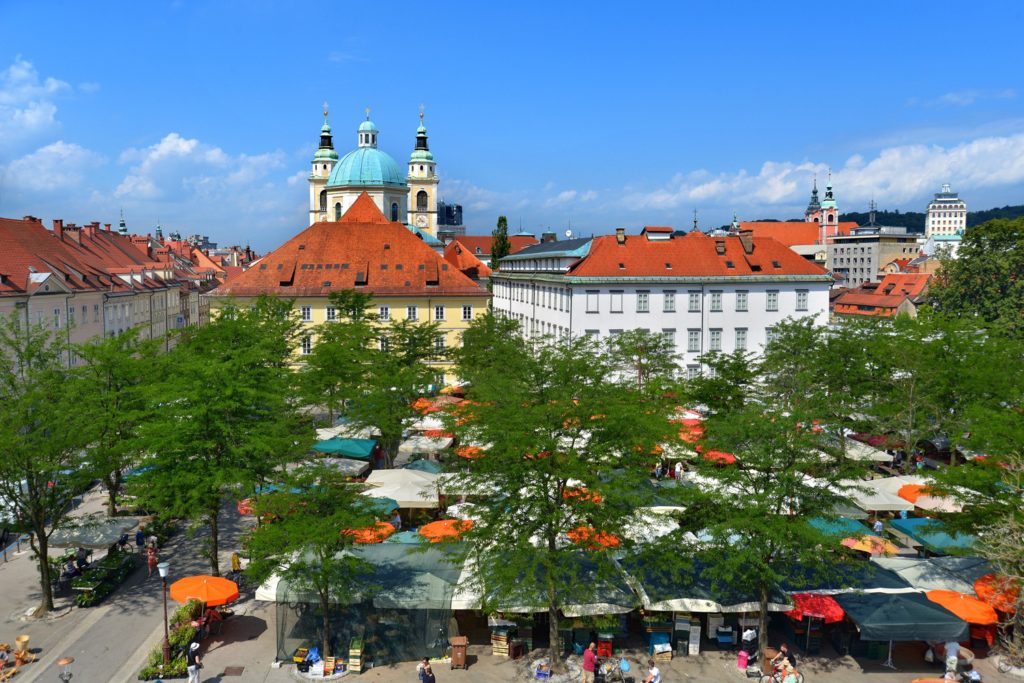 or, as Pat discovered, close up like this
or, as Pat discovered, close up like this
until 18:00 after which it transforms into parking lot sometime in the evening.
Now, back to my tale. The evening weather alternated between dry, misty, and full-on bursts of rain. In my wandering I found an interesting place to eat and ducked in just before one of these brief showers. The restaurant, called Street Food Valentin is attached to the much pricier high concept Restavracija Valentin. The parent is a fish and seafood restaurant with its own fish monger. Diners can select their fish and then have it cut and prepared to order. For someone like me, in search of lighter fare, there is the newly opened Street Food Valentin. There’s a window for take away or you can, as I did, sit on a stool inside where it shares space with the fish market.
As with any street food restaurant striving for some degree of authenticity, Street Food Valentin has a rather limited menu. (I found this photo on Trip Advisor.)
As I recall, I had the Fishburger Valentin, the small salad and a Laško – though two months distant from the meal my memory could be faulty.
I stretched out my dinner until the rain stopped and walked up the commercial street called Vodnikov Square. I passed a shop that had a mechanical dancing bear in the doorway in an effort to lure customers. The video I shot is, alas, gone with the rest.
I also passed the Ljubljana Cathedral whose official name is St. Nicholas’ Church. Our guide had taken us past the church on our first afternoon. Its green dome and twin towers make it easy to spot from a distance.
The earliest mention of a church occupying the site comes from 1262 but it didn’t become a cathedral until the Diocese of Ljubljana was established in 1461. The current building was erected at the beginning of the 18th century and was consecrated in 1707. However, the dome wasn’t constructed until 1841. Brdar’s statues of Adam and Eve are oriented as though they’re walking toward the church.
The church towers have six bells one of which is the second oldest bell in Slovenia and dates to 1326. There are also six sandstone statues of bishops and saints in the niches of the cathedral. However, the most notable exterior features are the bronze sculpted doors that were installed in 1996 when Pope John Paul II came to Ljubljana to help celebrate 1250 years of Christianity in Slovenian territory.
The front door
 with scenes depicting events from the nation’s history is called, appropriately enough, the Slovene Door. The side door is called the Ljubljana Door
with scenes depicting events from the nation’s history is called, appropriately enough, the Slovene Door. The side door is called the Ljubljana Door 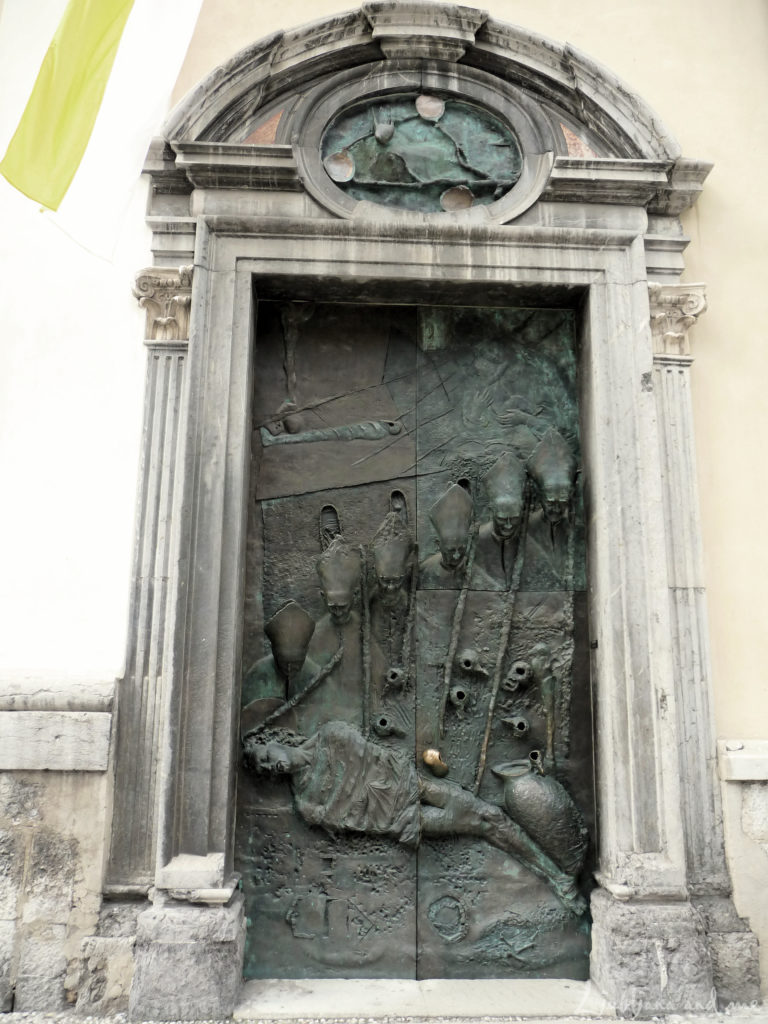
because of its portraits of the Bishops of Ljubljana from the 20th century.
I scream, you scream.
A marketing company call Sool Nua has, for the past two years, overseen a program aimed at finding the world’s best ice cream destinations. Their website describes their program, #worldICECREAMindex, as celebrating and recognizing the central role that ice cream plays in defining a destination and highlighting its authenticity and originality. In 2015, both Slovenia and Ljubljana were named the world’s top destination for the sweet treat. (They both fell a bit in 2016 with the U.S. taking over the top spot while Slovenia held-on to second. Ljubljana fell from first to fourth. Still for a country as small as Slovenia, something told me this was a place I should eat some ice cream.)
Sometime on the first day we passed a spot along the river called Cacao. It’s a restaurant but it’s also well known for its deserts and ice cream which you can buy at an outdoor cart. I was headed there for a second consecutive night because Diane and I had stopped there following our dinner at Druga Violina last night when I tried two flavors and one of them had sent waves of ecstasy over, around and through every taste bud on my tongue. The concoction was fig-walnut and I’m salivating even as I type this.
As I headed back toward the Triple Bridge, the skies opened again but I was able to duck under the cover of the open Arcade along the river.
During the day, this space is filled with vendors. On this particular night a group of young musicians – a pair of violinists, a violist, a guitarist, and an oboe player were jamming out some more melodies I didn’t recognize. They didn’t seem to be seeking any money – there was no hat or open instrument case so I had a few minutes of entertainment as I stood by discreetly waiting for the rain to pass. The performance was short lived as a bossy older man came and tried to shoo them away. He succeeded in getting them to pack their instruments but they, too, had to wait out the rain.
We all dispersed once it stopped. The musicians looked to be seeking another spot to play and I returned to Cacao where I purchased two scoops of the fig-walnut ice cream that I savored as I meandered back toward Prešeren Square where, at night, the Franciscan Church is dramatically lit.
I reached the hotel, collapsed, and let the day that began in Bled end in bed.

